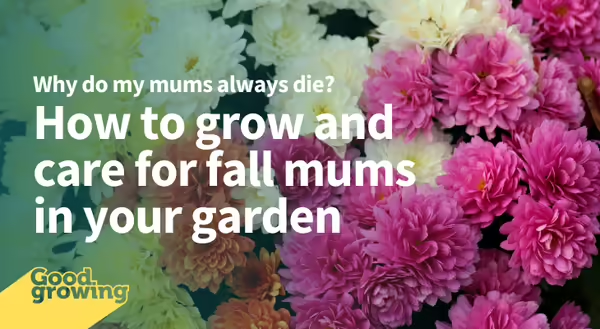
As the calendar turns from August to September, chrysanthemums (Chrysanthemum x morifolium), aka mums, start appearing in nurseries and garden centers. These plants are a staple in many landscapes in the fall and can provide some much-needed color to our landscapes when most other garden plants are starting to decline.
If you’ve gone shopping for mums, you’ve likely noticed a wide variety of bloom colors available. Flowers can range from green to yellow, orange to bronze, burgundy, red, pink, purple, and white. They can also be found in various flower shapes:
- Cushions – are double-flowered cultivars and have compact growth (usually less than 20” tall)
- Daises – have single, daisy-like flowers with yellow centers
- Decoratives – have double or semi-double flowers and typically grow over 18 inches tall
- Pompons – have small ball-shaped blooms, and plants are usually under 18 inches tall
- Buttons – Have small double flowers (less than 1 inch across) with plants usually under 18 inches tall
The National Chrysanthemum Society goes even further, dividing blooms into 13 different classes.
While we commonly treat them as annuals, mums are hardy from zones 5-9, meaning they can survive outdoors in Illinois (Illinois spans zones 5-7a). However, many people struggle to get mums to survive through the winter. So, what can be done to help mums survive in our landscapes?
When should mums be planted?
The biggest reason mums fail to overwinter is that we typically try to plant mums when they are most commonly available in the fall. Unfortunately, this isn’t the best time of year to be planting them. Spring is the ideal time to plant mums. Planting in spring gives the plants ample time to establish themselves in the landscape. So, if you’re planning on planting your mums in the fall, get them in the ground sooner rather than later.
Mulching mums
Mums also have a fairly shallow root system which makes them prone to heaving during the winter. This heaving (caused by repeated freezing and thawing of the soil) can severely damage or kill the plants. To help prevent this, apply 4 inches of mulch to your plants when the ground begins to freeze. This will help prevent wide swings in soil temperature and therefore heaving.
Since mums are shallow-rooted, they are also prone to drying out. Drought-stressed plants are less likely to survive the winter than well-watered plants. Therefore, they may need to be watered if conditions become dry. Mulching your plants will also help retain soil moisture.
Where to plant mums
Regardless of when you decide to plant your mums outdoors, they should be planted in an area with moist, well-drained soil. Mums don’t like having ‘wet feet,’ so avoid low spots and areas with heavy soils. Mums also need a site that receives full sun (at least 6 hours).
It may also help to place your mums in a protected location. Plants placed out in the open will be exposed to more extreme conditions and are more likely to be damaged than those planted in more protected locations, such as near the house.
Caring for mums
Once your mums have gone dormant in the fall, avoid the temptation to cut them back. Leaving the old growth will help provide an additional layer of protection to help get your plants through the winter.
Once growth resumes in the spring, remove the old growth from last year. When new growth gets 6 inches long, pinch off (remove) the growing tips. This will encourage bushier mums that will have more flowers. Plants can be pinched two to three times, with the last one taking place in late June/early July (July 4 is a common way people remember this). Make sure to water your plant throughout the growing season if the weather gets dry.
Mums will benefit from being divided every few years. This is also best done in spring, as soon as new growth starts to appear on plants. To divide, dig up the entire clump and remove the old center portion of the clump. Then cut up the remaining sections, making sure to have several shoots and a good root system on each.
Mums not blooming?
Mums produce flowers based on day length. Mums are short-day or, more accurately, long-night plants. This means that plants will not start producing flowers until a certain number of hours of darkness is reached (critical night length). You may have noticed some mums labeled as ‘early’ or ‘late-season.’ The reason some bloom earlier than others is because they have a shorter critical night length compared to ‘late-season' types.
One reason your mums may not be blooming is that you have a type/cultivar that requires a longer period of darkness, and we get a killing frost before they can produce flowers (for example, florists’ mums).
Another possibility is that somehow the dark period your plants are being exposed to is interrupted. This commonly happens when plants are planted near street or house lights. These lights interrupt the darkness and can delay flower production.
Good Growing Tip of the Week: Didn’t have time to get your mums in the ground? Try overwintering them indoors. After a hard frost, put your potted mums in a cool, dark location. Bring pots outdoors when it begins to warm up in the spring.
Resources and for more information:
Armitage, Allan M. Herbaceous Perennial Plants: A Treatise on Their Identification, Culture, and Garden Attributes. Fourth ed. Champaign, IL: Stipes Publishing, LLC, 2020.
Mum picture by _Alicja_ from Pixabay
Want to get notified when new Good Growing posts are available? SIGN ME UP!
Meet the author
Ken Johnson is a Horticulture Educator with University of Illinois Extension, serving Calhoun, Cass, Greene, Morgan, and Scott counties since 2013. Ken provides horticulture programming with an emphasis on fruit and vegetable production, pest management, and beneficial insects. Through his programming, he aims to increase backyard food production and foster a greater appreciation of insects.